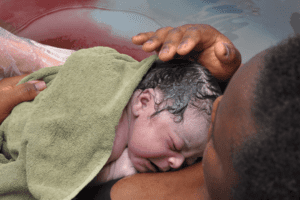Labor Complications: What is Chorioamnionitis?


Chorioamnionitis is when an infection develops in the uterus during labor. This condition complicates 1-4 percent of all deliveries. Also known as intra-amniotic infection, the diagnosis is made when a mom develops a fever during labor and no other cause for that fever can be found. Other signs that can point to chorioamnionitis are foul-smelling amniotic fluid, a high heart rate in mom or baby, and uterine tenderness.
One single organism is not responsible for chorioamnionitis. Rather, multiple bacteria can cause it. They can include Group B streptococcus, Escherichia coli, and staphylococcus, among others. Because of this, there is no one single test that can diagnose chorioamnionitis.
Once chorioamnionitis is suspected in labor, antibiotics should be started to help treat it. These are given in an IV and have been shown to improve outcomes for both moms and their babies. Different antibiotics can be used, so it depends on what is available at the hospital where you deliver and if you have any allergies. Of course, they are all safe to use in pregnancy! How long you are treated depends on if you deliver vaginally or by C-section and how long your fever lasts.
Certain risk factors exist for developing chorioamnionitis. These include having your bag of water broken for a very long time, prolonged labor, having many cervical exams, delivering by C-section, smoking, having diabetes, and being a carrier of GBS.
Although chorioamnionitis is treatable, the goal is to avoid certain complications that chorioamnionitis can cause. For moms, this condition puts them at increased risk of postpartum hemorrhage, need to deliver by C-section (mainly because an infected uterus does not contract as well), and bloodstream infections.
Babies whose moms develop chorioamnionitis in labor have some increased risks, too. They are more likely to develop a fever themselves, have a bloodstream infection, and develop problems with breathing. Because of this, many of these babies will be monitored after delivery. They usually have some screening blood tests and may be put on intravenous antibiotics to treat any suspected infection to avoid long-term complications.
The good news is that most moms and babies whose deliveries are complicated by chorioamnionitis recover just fine. While some infections happen in women with no risk factors, the best way to try to prevent it is to avoid the risk factors that can be adjusted. This includes not smoking, keeping your diabetes under good control, and having cervical exams in labor only when they are really needed.
Sources:
- Guidelines for Perinatal Care, 7th edition
- The American College of Obstetricians and Gynecologists and the American Academy of Pediatrics
- 2012.
ATN Tita and WW Andrews - Diagnosis and management of clinical chorioamnionitis
- Clin Perinatol , 2010 Jun: 37(2):339-354.
Powered by Bundoo®










































